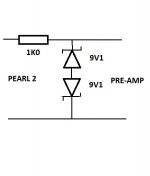I removed the protection circuit and C1 from my Aleph J (DC amplifier), which is a huge risk on my behalf..... but it sounds so good, stunning relly. Had to wait so long in my life to get to that point when I can say: this sounds right! I could never go back no matter how high the risk is.
But, to be honest, I am driving the amplifier of a 33 ohms I/V resistor, so the chance of Aleph J seeing a high amplitude pulse is minimal...
+ I always turn Aleph J ON last, once the music starts playing from the DAC, so there are 0 issues.
I wouldn't include a really in the signal path no matter what the risk is.
Which definitely does not mean that providing a (safety??) relays is a bad thing. It all depends on your approach to risk assessment, and what is important to you.
But, to be honest, I am driving the amplifier of a 33 ohms I/V resistor, so the chance of Aleph J seeing a high amplitude pulse is minimal...
+ I always turn Aleph J ON last, once the music starts playing from the DAC, so there are 0 issues.
I wouldn't include a really in the signal path no matter what the risk is.
Which definitely does not mean that providing a (safety??) relays is a bad thing. It all depends on your approach to risk assessment, and what is important to you.
I wouldn't include a really in the signal path no matter what the risk is.
Please think of the more or less standard solution in quality stuff to short output via a resistor (oh oh!) to GND with a small relay. A few seconds after power up the relays contacts open and no harm is done. You are entitled to your opinion but please don't spread wrong info. A muting relay that shorts to GND is NOT in the signal path. From cheap Chinese devices to expensive high end, many of these devices have them. These are the products that don't have that annoying plop at power up and don't damage other devices (or burn woofers elsewhere in the chain) when they decide to go to semiconductor heaven.
It is embarrassing to have to explain the importance of a standard 1 $ solution that has proven itself for tens of years. Anyone involved in this hobby has at least experienced once that stuff went bad when there was no protection built into the device. A well engineered device should cause no harm at power up/power down, preferably also at break down and there should be no need for a certain power up sequence.
Last edited:
Please think of the more or less standard solution in quality stuff to short output via a resistor (oh oh!) to GND with a small relay. A few seconds after power up the relays contacts open and no harm is done. You are entitled to your opinion but please don't spread wrong info. A muting relay that shorts to GND is NOT in the signal path. From cheap Chinese devices to expensive high end, many of these devices have them. These are the products that don't have that annoying plop at power up and don't damage other devices (or burn woofers elsewhere in the chain) when they decide to go to semiconductor heaven.
It is embarrassing to have to explain the importance of a standard 1 $ solution that has proven itself for tens of years. Anyone involved in this hobby has at least experienced once that stuff went bad when there was no protection built into the device. A well engineered device should cause no harm at power up/power down, preferably also at break down and there should be no need for a certain power up sequence.
Did you read my reply?
“Which definitely does not mean that providing a (safety??) relays is a bad thing.”
oh oh! You did not!
K & D,
I prefer a clamp solution that biases the zener diodes out of the way with normal diodes and a couple of resistors to the +/- rails to minimize the nonlinear capacitance hanging off he input signal path. I'll show an example when I get around to posting my latest headphone amp circuit.
I prefer a clamp solution that biases the zener diodes out of the way with normal diodes and a couple of resistors to the +/- rails to minimize the nonlinear capacitance hanging off he input signal path. I'll show an example when I get around to posting my latest headphone amp circuit.
